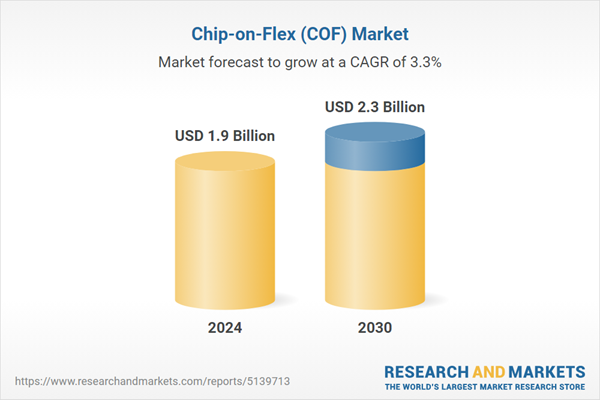The global market for Chip-on-Flex (COF) was valued at US$1.9 Billion in 2024 and is projected to reach US$2.3 Billion by 2030, growing at a CAGR of 3.3% from 2024 to 2030. This comprehensive report provides an in-depth analysis of market trends, drivers, and forecasts, helping you make informed business decisions. The report includes the most recent global tariff developments and how they impact the Chip-on-Flex (COF) market.
Segments: Segment (Single Sided COF, Other Segments); End-Use (IT & Telecom, Automotive, Aerospace & Defense, Consumer Electronics, Other End-Uses).
Geographic Regions/Countries: World; United States; Canada; Japan; China; Europe (France; Germany; Italy; United Kingdom; and Rest of Europe); Asia-Pacific; Rest of World.
The analysts continuously track trade developments worldwide, drawing insights from leading global economists and over 200 industry and policy institutions, including think tanks, trade organizations, and national economic advisory bodies. This intelligence is integrated into forecasting models to provide timely, data-driven analysis of emerging risks and opportunities.
Global Chip-on-Flex (COF) Market - Key Trends and Drivers Summarized
Why Is Chip-on-Flex (COF) Technology Crucial in Modern Electronics?
Chip-on-Flex (COF) technology has become a pivotal component in the advancement of modern electronics, especially in devices that require flexibility and compactness. But what makes COF technology so essential today? COF refers to the process of directly mounting integrated circuits (ICs) onto a flexible printed circuit (FPC) substrate. This method allows for a significant reduction in space, enabling manufacturers to develop smaller, lighter, and more durable devices. COF technology is widely used in industries such as consumer electronics, automotive, healthcare, and wearables, where flexible displays, compact designs, and reliable performance are increasingly required. Its ability to integrate ICs on flexible substrates ensures that electronics can be more adaptable to varying shapes and uses, making COF indispensable in products like foldable smartphones, flexible displays, and medical devices that demand a lightweight, bendable structure. As the demand for portable and flexible electronic devices continues to grow, COF technology is playing a critical role in enabling this transition.How Does COF Technology Meet the Demands of Miniaturization and Flexibility?
The shift towards smaller, more versatile electronic devices has posed significant challenges for designers, but COF technology offers solutions to many of these issues. One of the key benefits of COF technology is its ability to accommodate flexible substrates, which can be bent or folded without damaging the underlying circuits. This makes it a preferred choice for products like foldable smartphones, wearable electronics, and curved displays. Unlike traditional methods that use rigid substrates, COF allows for seamless integration of ICs into flexible and compact designs. This flexibility also reduces the weight of electronic devices, making them more portable and user-friendly. Moreover, COF technology allows for the placement of multiple ICs onto a single flexible substrate, which maximizes the use of space and minimizes the overall footprint of the device. Another critical advantage of COF technology is its ability to support high-density interconnections, which is crucial for devices with multiple functions that require complex circuitry. This feature makes COF particularly valuable in sectors like automotive electronics and medical devices, where high performance, reliability, and compactness are necessary. Additionally, COF enhances the durability of electronic devices, as the flexible substrate provides better resistance to physical stress, reducing the risk of breakage or damage in devices that are frequently bent or folded. This combination of miniaturization, flexibility, and robustness positions COF technology as an essential solution for the next generation of compact and portable electronics.What Technological Advancements Are Shaping the Future of Chip-on-Flex (COF)?
As the electronics industry evolves, several technological advancements are pushing the boundaries of Chip-on-Flex (COF) technology. One of the most notable advancements is in the materials used for flexible substrates. Newer materials, such as polyimide and polyethylene terephthalate (PET), offer superior flexibility, thermal resistance, and mechanical strength, which allow COF assemblies to withstand harsh environments and high temperatures. These materials are particularly beneficial in automotive, aerospace, and military applications where electronics must operate reliably under extreme conditions. The development of these advanced substrates is enabling COF technology to be integrated into more challenging applications while enhancing the durability and performance of the devices. Another significant advancement is in the miniaturization of components, particularly the ability to place ultra-thin ICs directly onto flexible substrates without sacrificing performance. The ongoing improvements in semiconductor manufacturing have allowed for thinner, more efficient chips that can be mounted on flexible circuits with higher precision and reliability. This has been crucial in the development of compact devices such as wearables and medical implants, where space is at a premium. Additionally, advancements in automated assembly processes, such as high-speed pick-and-place machines and precision bonding techniques, have increased the production efficiency of COF technology. This has made COF more accessible and cost-effective for mass production, ensuring that it can keep up with the growing demand for flexible and compact electronics in various industries.What Is Driving the Growth of the Chip-on-Flex (COF) Market?
The growth in the Chip-on-Flex (COF) market is driven by several factors, including the increasing demand for flexible electronics, the miniaturization of devices, and advancements in materials and manufacturing technologies. One of the primary drivers of COF adoption is the expanding market for foldable smartphones, wearable devices, and flexible displays, which require flexible circuits that can support complex functionality in a compact form. As consumer electronics manufacturers push the boundaries of design with foldable and curved screens, COF technology is becoming indispensable for enabling these innovations. Additionally, the automotive sector’s shift toward advanced driver-assistance systems (ADAS) and electric vehicles (EVs) has created new opportunities for COF, as these vehicles rely on flexible electronics for sensors, control units, and displays that require both compactness and reliability. Moreover, the rise of wearable healthcare devices, such as fitness trackers and medical sensors, has further accelerated the demand for COF technology. These devices must be lightweight, flexible, and durable, characteristics that COF technology can provide. The growth of the Internet of Things (IoT) has also fueled demand for COF, as more connected devices require compact, flexible circuits to fit into small form factors while maintaining high performance. Advancements in manufacturing processes, such as improved automation and precision placement, have made COF production more cost-effective, expanding its use across industries. As consumer behavior continues to favor smaller, more powerful devices, and industries increasingly adopt flexible electronics, the COF market is poised for continued growth, driven by its ability to meet the technical demands of modern applications.Report Scope
The report analyzes the Chip-on-Flex (COF) market, presented in terms of units. The analysis covers the key segments and geographic regions outlined below.Segments: Segment (Single Sided COF, Other Segments); End-Use (IT & Telecom, Automotive, Aerospace & Defense, Consumer Electronics, Other End-Uses).
Geographic Regions/Countries: World; United States; Canada; Japan; China; Europe (France; Germany; Italy; United Kingdom; and Rest of Europe); Asia-Pacific; Rest of World.
Key Insights:
- Market Growth: Understand the significant growth trajectory of the Single Sided COF segment, which is expected to reach US$2.1 Billion by 2030 with a CAGR of a 3.1%. The Other Segments segment is also set to grow at 5.7% CAGR over the analysis period.
- Regional Analysis: Gain insights into the U.S. market, valued at $517.1 Million in 2024, and China, forecasted to grow at an impressive 3.2% CAGR to reach $369.7 Million by 2030. Discover growth trends in other key regions, including Japan, Canada, Germany, and the Asia-Pacific.
Why You Should Buy This Report:
- Detailed Market Analysis: Access a thorough analysis of the Global Chip-on-Flex (COF) Market, covering all major geographic regions and market segments.
- Competitive Insights: Get an overview of the competitive landscape, including the market presence of major players across different geographies.
- Future Trends and Drivers: Understand the key trends and drivers shaping the future of the Global Chip-on-Flex (COF) Market.
- Actionable Insights: Benefit from actionable insights that can help you identify new revenue opportunities and make strategic business decisions.
Key Questions Answered:
- How is the Global Chip-on-Flex (COF) Market expected to evolve by 2030?
- What are the main drivers and restraints affecting the market?
- Which market segments will grow the most over the forecast period?
- How will market shares for different regions and segments change by 2030?
- Who are the leading players in the market, and what are their prospects?
Report Features:
- Comprehensive Market Data: Independent analysis of annual sales and market forecasts in US$ Million from 2024 to 2030.
- In-Depth Regional Analysis: Detailed insights into key markets, including the U.S., China, Japan, Canada, Europe, Asia-Pacific, Latin America, Middle East, and Africa.
- Company Profiles: Coverage of players such as AKM Industrial Company Ltd., Chipbond Technology, Compass Technology Company, Compunetics, CWE and more.
- Complimentary Updates: Receive free report updates for one year to keep you informed of the latest market developments.
Some of the 46 companies featured in this Chip-on-Flex (COF) market report include:
- AKM Industrial Company Ltd.
- Chipbond Technology
- Compass Technology Company
- Compunetics
- CWE
- Danbond Technology
- Flexceed
- LG INNOTEK
- LGIT corporation
- Shenzhen Danbang Technology Co., Ltd.
- STARS Microelectronics
- Stemko Group
Tariff Impact Analysis: Key Insights for 2025
Global tariff negotiations across 180+ countries are reshaping supply chains, costs, and competitiveness. This report reflects the latest developments as of April 2025 and incorporates forward-looking insights into the market outlook.The analysts continuously track trade developments worldwide, drawing insights from leading global economists and over 200 industry and policy institutions, including think tanks, trade organizations, and national economic advisory bodies. This intelligence is integrated into forecasting models to provide timely, data-driven analysis of emerging risks and opportunities.
What’s Included in This Edition:
- Tariff-adjusted market forecasts by region and segment
- Analysis of cost and supply chain implications by sourcing and trade exposure
- Strategic insights into geographic shifts
Buyers receive a free July 2025 update with:
- Finalized tariff impacts and new trade agreement effects
- Updated projections reflecting global sourcing and cost shifts
- Expanded country-specific coverage across the industry
Table of Contents
I. METHODOLOGYII. EXECUTIVE SUMMARY2. FOCUS ON SELECT PLAYERSIII. MARKET ANALYSISIV. COMPETITION
1. MARKET OVERVIEW
3. MARKET TRENDS & DRIVERS
4. GLOBAL MARKET PERSPECTIVE
UNITED STATES
CANADA
JAPAN
CHINA
EUROPE
FRANCE
GERMANY
ITALY
UNITED KINGDOM
REST OF EUROPE
ASIA-PACIFIC
REST OF WORLD
Companies Mentioned (Partial List)
A selection of companies mentioned in this report includes, but is not limited to:
- AKM Industrial Company Ltd.
- Chipbond Technology
- Compass Technology Company
- Compunetics
- CWE
- Danbond Technology
- Flexceed
- LG INNOTEK
- LGIT corporation
- Shenzhen Danbang Technology Co., Ltd.
- STARS Microelectronics
- Stemko Group
Table Information
| Report Attribute | Details |
|---|---|
| No. of Pages | 223 |
| Published | April 2025 |
| Forecast Period | 2024 - 2030 |
| Estimated Market Value ( USD | $ 1.9 Billion |
| Forecasted Market Value ( USD | $ 2.3 Billion |
| Compound Annual Growth Rate | 3.3% |
| Regions Covered | Global |









